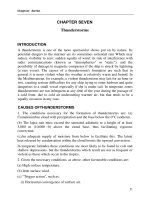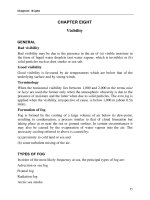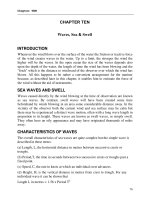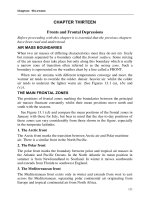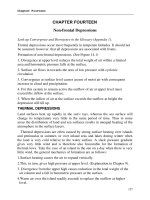BÀI GIẢNG KHÍ TƯỢNG LÝ THUYẾT CHƯƠNG 12
Bạn đang xem bản rút gọn của tài liệu. Xem và tải ngay bản đầy đủ của tài liệu tại đây (116.5 KB, 7 trang )
Chapter Twelve
CHAPTER TWELVE
Isobaric Patterns
Out of seven characteristic isobaric patterns there are only two types of weather
systems which are fundamental-the depression and the anticyclone-the
remainder being either outward extensions from one of these or a neutral area
between them.
These seven distinctive isobaric forms are:
Depression
Anticyclone
Secondary depression
Trough
Wedge or Ridge Depressions, fronts and anticyclones are
Col
discussed in greater detail in later chapters.
Straight Isobars
DEPRESSION (or LOW)
An area of low barometric pressure surrounded by an area in which the
pressure is relatively high. The isobars are roughly circular or oval in shape
and, in accordance with Buys Ballot's Law (see Chapter 9) the wind flows in
an anticlockwise direction round the area of low pressure in the northern
hemisphere (see Figure 12.1) and clockwise in the southern hemisphere.
It should be noted that in both hemispheres the surface wind flows slightly in
towards the central area (see Convergence in Appendix 1) where the worst
weather is usually encountered.
Depressions are of greatly varying intensities and are usually associated with
bad weather-Leo much cloud and precipitation with strong or gale force winds,
especially near the centre of the system, the severity of the weather being
governed mainly by the steepness of the pressure gradient and the moisture
content of the surface air, but there are other important factors involved.
Despite the availability of official weather forecasts it is important for a
mariner to be able to recognise the precursory signs of bad weather and to
know the weather sequence, shift of wind, etc. which may be expected with the
approach, passage and retreat of a well defined depression. Indeed, the safety
of his ship may well depend on such knowledge and his ability to act on it.
104
Chapter Twelve
The term depression is commonly applied to cyclones in latitudes which lie
outside the tropics but may also be used to describe a weak tropical cyclone.
As a depression develops the pressure gradient becomes steeper and the
winds stronger, isobars on each successive weather chart are drawn closer
together and the depression is said to deepen. A weakening or dying depression
is said to be filling up.
Depressions tend to move towards areas of low or falling pressure and to
steer round high pressure regions.
ANTICYCLONE
A region of high pressure surrounded by an area of relatively low pressure. The
isobars are roughly circular or oval in shape. In the northern hemisphere the
wind circulates in a clockwise direction round the centre of high pressure: the
converse is true for the southern hemisphere. (See Figure 12.2).
General characteristics
The pressure gradient is slight, winds are light near the centre. Weather is
usually quiet. dry and settled. Land and sea breezes (see Chapter 9) are marked.
especially during the warmest months of the year.
In summer the weather is generally dry, sunny and warm but within the outer
portions of the system it is often cloudy with some rain.
In winter the weather may be one of two types:
(a) Cloudless sky with sharp frosts at night or radiation fog.
(b) The sky completely covered by stratus cloud. Dull, cold and foggy or misty
weather may persist for some days. (See Anticyclonic gloom in Appendix 1).
High pressure systems are usually slow moving by comparison with other
systems and often remain stationary for long periods. An anticyclone is said to
intensify as the pressure within the system rises, whereas when pressure falls.
thereby weakening the system, it is said to decline.
A SECONDARY DEPRESSION
A secondary depression is one which forms within the isobaric pattern of
another (primary) depression. When the primary depression is old and filling
up, the secondary may develop and deepen till it completely absorbs all traces
of the primary. The secondary in Figure 12.3 has a steeper gradient and lower
pressure at its centre than the primary or parent depression. Note that secondary
depressions often develop into much more vigorous systems than their
primaries.
105
Chapter Twelve
TROUGH OF LOW PRESSURE
This is distinguished on the weather chart by a system of isobars which appear
sharply curved (concave towards low pressure) along a line called the trough
line within a depression. (See Figure 12.6).
The wind circulation, anticlockwise in the northern hemisphere, is
indicated by the arrows. In the southern hemisphere the wind flows
clockwise round the low pressure centre. Note that the isobars are
closer together near the centre.
The wind circulation, clockwise in the northern hemisphere, is
indicated by the arrows. Note that the isobars are more widely spaced
near the centre of high pressure and that the surface wind tends to flow
outwards from the centre.
106
Chapter Twelve
A trough may be termed deep or shallow according to whether the curvature of
the isobars is acute or gentle, respectively. The weather associated with a
trough is generally cloudy with precipitation. (See Line squall in Appendix 1).
Fronts
Fronts, which are dealt with in later chapters, are all troughs; but a trough is not
always a front. When the isobars of a depression or a tropical cyclone are
circular the term trough refers to a line drawn through the centre of the system
at right angles to the line of progression of the centre.
RIDGE (OR WEDGE) OF HIGH PRESSURE
A wedge shaped extension of an anticyclone between two areas of low
pressure. (See Figures 12.4 and 12.6). The isobars assume their greatest
curvature along the axis of the ridge. It is generally associated with the fair
weather of the anticyclone, often having light winds along the central portion.
A ridge in which the isobars are sharply curved generally moves faster than a
"flat" ridge.
107
Chapter Twelve
108
Chapter Twelve
COL
An area of indeterminate pressure located between two highs and two lows
which are arranged alternately. (See Figures 12.5 and 12.6). It is generally
associated with light variable winds, often thundery in summer and dull or
foggy or misty in winter. In Figure 12.5 the wind circulation round the four
systems is shown by arrows. It is easy to see why the winds are variable within
the col area.
STRAIGHT ISOBARS
An atmospheric pressure distribution in which the isobars run in more or less
parallel straight lines across a large area. (See Figure 12.7). It is usually the
outlying portion of a large and distant depression or anticyclone.
109
Chapter Twelve
QUESTIONS
1. Name the seven characteristic isobaric forms.
2 Define the terms depression and anticyclone.
3. (a) Sketch the isobars, fronts and wind circulation in a typical southern
hemisphere depression. (b) What are the two main factors which govern the
severity of the weather in any middle-latitude depression?
4. In which direction do depressions tend to move?
5. Describe the general characteristics of an anticyclone: (a) In summer. (b) In
winter.
6. Describe the weather associated with a co!: (a) In summer. (b) In winter.
7.
What mainly governs the weather conditions to be expected in a system of
straight isobars?
110

